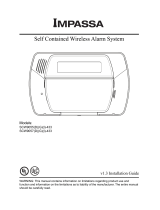
Introduction
Introduction
The HS2TCHP Touchscreen is an interactive touch-sensitive color LCD that can be used on any PowerSeries
Neo control panel. Due to the custom requirements of individual installations, some of the features
described here may perform differently than described. Refer to your Installer's Instructions for the details of
your specific installation and to the User Manual for general security system information.
General System Operation
Your security system is made up of a DSC control panel, one or more keypads and various sensors and
detectors. The control panel will be mounted out of the way in a utility closet or in a basement. The metal
cabinet contains the system electronics, fuses and standby battery.
Note: Only the installer or service professional shall have access to the control panel.
All the keypads have an audible indicator and command entry keys. The keypad is used to send commands
to the system and to display the current system status. The keypad(s) will be mounted in a convenient loc-
ation inside the protected premises close to the entry/exit door(s).
The security system has several zones of protection, each connected to one or more sensors (motion detect-
ors, glassbreak detectors, door contacts, etc.). See Alarm Memory on page 12 for information on sensors in
alarm for this Touchscreen keypad.
About Your Security System
Your DSC Security System has been designed to provide you with the greatest possible flexibility and con-
venience. Read this manual carefully and have your installer instruct you on your system's operation and on
which features have been implemented in your system. All users of this system should be equally instructed
in its use. Fill out the “System Information” page with all of your zone information and access codes and
store this manual in a safe place for future reference
Note: The PowerSeries security system includes specific false alarm reduction features and is classified in
accordance with ANSI/SIA CP-01-2010 Control Panel Standard - Features for False Alarm Reduction. Please
consult your installer for further information regarding the false alarm reduction features built into your sys-
tem as all are not covered in this manual.
Carbon Monoxide Detection (must be enabled by your Installer)
This equipment is capable of monitoring carbon monoxide detectors and providing a warning if carbon
monoxide is detected. Please read the Family Escape Planning guidelines in this manual and instructions
that are available with the carbon monoxide detector.
Fire Detection (must be enabled by your Installer)
This equipment is capable of monitoring fire detection devices such as smoke detectors and providing a
warning if a fire condition is detected. Good fire detection depends on having adequate number of detectors
placed in appropriate locations. This equipment should be installed in accordance with NFPA 72 (N.F.P.A.,
Batterymarch Park, Quincey MA 02269). Carefully review the Family Escape Planning guidelines in this
manual.
Testing
To ensure that your system continues to function as intended, you must test your system weekly. Please
refer to the “Testing your System” section in this manual. If your system does not function properly, call
your installing company for service.
Monitoring
This system is capable of transmitting alarms, troubles and emergency information to a central station. If
you initiate an alarm by mistake, immediately call the central station to prevent an unnecessary response.
Note: The monitoring function must be enabled by the installer before it becomes functional.
- 5 -





















